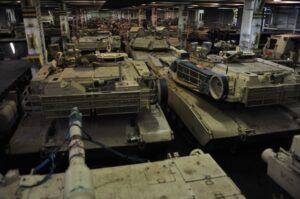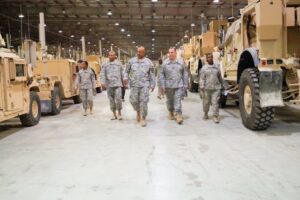
Army mechanics repair a battle-damaged Stryker in Kuwait.
WASHINGTON: Army Chief of Staff Gen. Mark Milley says over and over that his top priority to getting the Army ready to “fight tonight.” What does that mean in practice? For Army Materiel Command, which keeps troops supplied, it means literally putting its money where his mouth is.

Gen. Gus Perna
If readiness for major combat operations is really the service’s No. 1 priority, Army officials have to be ready to pay for it – even in areas where they once let considerations of cost efficiency trump combat effectiveness. The changes range from issuing more spare parts so units can train harder to upgrading equipment cached in Army Prepositioned Stocks, to buying data rights from contractors.
This shift requires a major cultural change for both defense contractors and Army officials, AMC’s commander said. “The most important (change) in my view was getting our lawyers involved and our contracting folks and breaking the paradigm, taking them off the hamster wheel,” Gen. Gus Perna told reporters this morning. “We weren’t doing anything wrong, but we were allowing ourselves to make decisions…based on the wrong metrics.”

An M1 tank of 3rd Armored Brigade Combat Team, 4th Infantry Division, unloads in Bremerhaven, Germany in January.
Intellectual Property
Perna was talking particularly about the challenges of intellectual property. Historically, the military has bought vehicles, weapons, and other equipment from contractors, but the contractors retain the intellectual property rights to the designs. That makes it much harder for the military to hire another company to manufacture spare parts or upgrade the equipment. In many cases, the original contractor has a monopoly on maintenance and modernization contracts, a phenomenon known as “vendor lock.”
Companies naturally view government efforts to acquire their intellectual property with suspicion, especially if the proffered price is low. When Perna discussed his new approach to IP with industry representatives, he said, “at first” the reaction was often surprised dismay. He emphasized that his appetite was limited: “It’s not the entire intellectual property, but it’s the data rights that I need to produce…repair parts in support of the vehicle.”
“We got used to not asking for the tech data rights…because it cost too much money, Perna said. “So I’ve challenged my lawyers and contracting officers to get involved and challenge that and not just to roll over at the first dollar amount.”

M1 tanks of 3rd Armored Brigade Combat Team, 4th Infantry Division, await unloading in Bremerhaven, Germany in January.
Even after tough negotiations, though, “intellectual property, rightly so, should cost some money,” Perna said. “The up-front (cost) is significant,” he said, but it will allow greater savings over the life of a program by increasing competition for spare parts, maintenance, and upgrades.
Owning data rights will also improve readiness, Perna said, at least for frontline equipment that must go places that contractor service representatives can’t. In 15 years in Iraq and Afghanistan, he said, the Army became dependent on contractor personnel to do even routine maintenance. That worked in warzones where soldiers could regular returning to large, fixed Forward Operating Bases where civilians could work in safety.
In a war against an advanced “near peer” adversary like Russia, however, big bases will be easy targets for long-range rockets, and troops will have to keep constantly on the move, as Gen. Milley himself has said. Troops will have to leave the civilian contractors behind and keep their gear in working order themselves. To do that properly, they need full access to the technical data.
(One potential breakthrough Gen. Perna didn’t mention: 3D printing. If soldiers have the technical data on a part, they have the legal right and the physical specifications required to make their own with a 3D printer, potentially bypassing the lengthy and time-consuming supply chain. This technique is still nascent but may be essential to realizing the Army’s vision of rapidly moving, widely dispersed, and logistically self-sufficient formations).
“It is about operational risk and decision making,” Perna said. “Sometimes we don’t need it (the data rights, because) there’s equipment that won’t be forward on the battlefield, and we can count on industry to maintain it and sustain it….but if equipment’s going to be forward and soldiers are going to do it (maintenance), then it’s worth it to go after the tech data rights.”

Army M2 Bradley armored vehicles being shipped to a stockpile in South Korea.
Supply & Demand
Data rights isn’t the only thing Perna is willing to shell out for. He also revised the long-established and fairly stingy formula that AMC used to allocate parts to Army brigades, called the Authorized Stockage List. “The algorithm was based on (usage for) one major training event a year,” he said, which is unrealistically low. “I’ve thought so since I was a second lieutenant, and now I’m finally in a place where I get to influence the change.”
After briefing the Chief of Staff and getting his approval, Perna revised the formula so units would get enough spare parts to keep up their “maximum effort” in intensive training for major war. In many cases, primarily armored fighting vehicles that weren’t used as much in the counterinsurgency area – M1 tanks, M2 Bradleys, 8×8 Strykers – this requires rebuilding “atrophied” supply chains to get industry building the spare parts in quantity again.
“The algorithm now is focused on maintaining Army readiness, material readiness,” Perna said. “In the past…it was constrained by dollars.” Yes, issuing spare parts more generously costs more money. But if it lets troops repair their vehicles after hard training and get right back in the simulated fight, the new approach may save lives in actual battles.
Perna’s made similar investments in equipment that’s not assigned to any Army brigade but is rather waiting in warehouses for a crisis: the Army Prepositioned Sets. The basis of APS is that it’s much quicker and easier to fly troops overseas in a crisis than to send their heavy equipment, which requires rare, specialized transport aircraft or slow-moving ships. APS keeps a brigade’s worth of equipment in various locations around the world, such as Europe. When a crisis looms, the Army can simply fly in a brigade’s troops and have them break out the APS equipment – in theory.

Army officers inspect one small portion of the massive logistics base at Camp Arifjan in Kuwait.
In practice, APS sets had the major items of equipment such as vehicles, but they’re missing all sorts of small “enablers.” The incoming brigade had to strip these enablers off its equipment at home base, pack them on the plane, and then install them on the APS equipment. Then test everything to make sure it really worked, and if it didn’t, then take it back off and re-reinstall it until it did work. That risked breaking the equipment and took a lot of time.
Now, however, Army Materiel Command is installing all those enablers on the vehicles in the APS warehouses, long before the combat troops arrive. It’s also changing the fluids in the vehicles and taking other measures to ensure they’re ready to roll as soon as the incoming brigade arrives.
Perna wouldn’t say how long things took the old way, but he says the timeline to break out APS gear – from the moment he gets the order to the moment the brigade drives away from the warehouse – is now down to 96 hours.
That tighter timeline should make potential adversaries like Russia take Army Prepositioned Stocks more seriously. “People know where that equipment is around the world,” Perna said. “(That’s) a deterrent in itself.”
Norway’s air defense priorities: Volume first, then long-range capabilities
“We need to increase spending in simple systems that we need a huge volume of that can, basically, counter very low-tech drones that could pose a threat,” Norway’s top officer told Breaking Defense, “so we don’t end up using the most sophisticated missile systems against something that is very cheap to buy.”


























